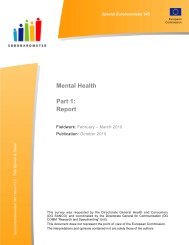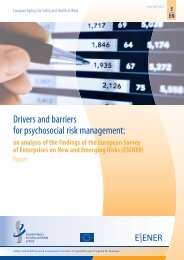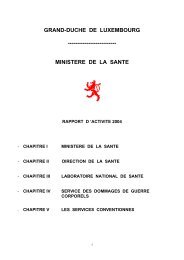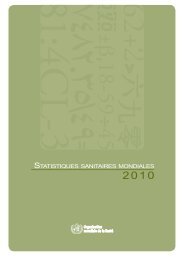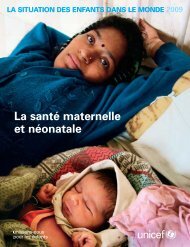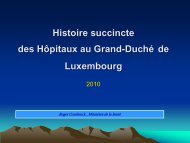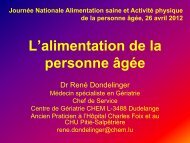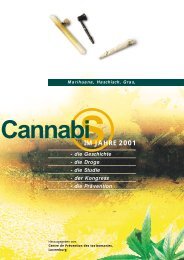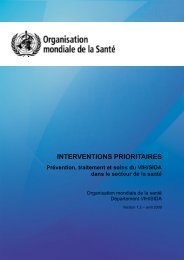Global Tuberculosis Control 2010 - Florida Department of Health
Global Tuberculosis Control 2010 - Florida Department of Health
Global Tuberculosis Control 2010 - Florida Department of Health
You also want an ePaper? Increase the reach of your titles
YUMPU automatically turns print PDFs into web optimized ePapers that Google loves.
his section examines the latest data on implementation<br />
<strong>of</strong> the Stop TB Strategy, and compares progress<br />
with the targets included in the <strong>Global</strong> Plan to Stop TB,<br />
2011–2015 where applicable. The first three topics covered<br />
are case notifications, treatment success rates for<br />
sputum smear-positive TB patients and case detection<br />
rates for all forms <strong>of</strong> TB. These all illustrate progress in<br />
implementing DOTS – the foundation <strong>of</strong> the Stop TB<br />
Strategy. The fourth topic is the engagement <strong>of</strong> the full<br />
range <strong>of</strong> care providers in TB control (component 4 <strong>of</strong><br />
the strategy) through PPM. Such engagement is essential<br />
to ensure high levels <strong>of</strong> case detection and treatment<br />
success. The next two sections cover collaborative TB/<br />
HIV activities and the diagnosis and treatment <strong>of</strong> drugresistant<br />
TB, both <strong>of</strong> which fall under component 2 <strong>of</strong><br />
the Stop TB Strategy.<br />
Boxes are used to feature four topics – laboratory<br />
strengthening, HRD, strengthened surveillance and<br />
rational use <strong>of</strong> anti-TB medicines. All four topics are<br />
closely related to health-system strengthening (component<br />
3 <strong>of</strong> the Stop TB Strategy) as well as DOTS and the<br />
engagement <strong>of</strong> all care providers. ACSM, community TB<br />
care and research (components 5 and 6 <strong>of</strong> the strategy)<br />
are not discussed because there are limitations in the<br />
available data. In future, additional efforts to compile<br />
better data on these topics will be needed. The data that<br />
are currently available as well as data for all other topics<br />
covered in the <strong>2010</strong> data collection form can be viewed<br />
and downloaded on the WHO web site (www.who.int/tb/<br />
data).<br />
<br />
In 2009, 5.8 million cases <strong>of</strong> TB (new cases and relapse<br />
cases) were notified to NTPs, including 2.6 million new<br />
cases <strong>of</strong> sputum smear-positive pulmonary TB, 2.0 million<br />
new cases <strong>of</strong> sputum smear-negative pulmonary TB<br />
(including cases for which smear status was unknown),<br />
0.9 million new cases <strong>of</strong> extrapulmonary TB and 0.3 million<br />
relapse cases (). 1<br />
Among pulmonary cases, 57% <strong>of</strong> global notifications<br />
were sputum smear-positive. Among the 22 HBCs, the<br />
percentage <strong>of</strong> notified cases <strong>of</strong> pulmonary TB that were<br />
sputum smear-positive was relatively low in Zimbabwe<br />
(29%), the Russian Federation (31%), Pakistan (42%),<br />
<br />
<br />
<br />
<br />
<br />
<br />
<br />
<br />
<br />
<br />
<br />
<br />
<br />
<br />
<br />
<br />
<br />
<br />
<br />
<br />
<br />
<br />
<br />
<br />
<br />
<br />
<br />
<br />
<br />
<br />
<br />
<br />
<br />
<br />
<br />
<br />
<br />
<br />
<br />
<br />
<br />
<br />
<br />
<br />
<br />
<br />
<br />
1<br />
No distinction is made between DOTS and non-DOTS programmes. This is because by 2007, virtually all (more than 99%) notified cases were<br />
reported to WHO as treated in DOTS programmes. Since 2009, the WHO data collection form has made no distinction between notifications<br />
in DOTS and non-DOTS programmes.



